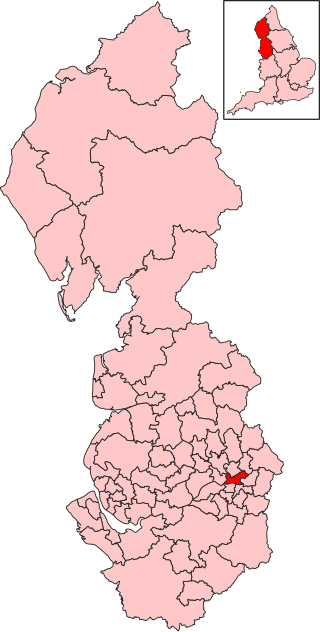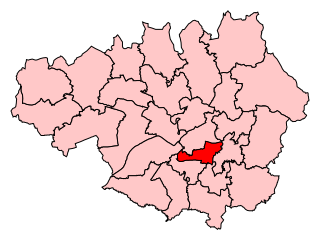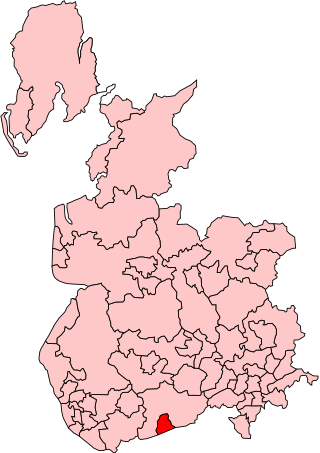Related Research Articles

Hexham is a constituency in Northumberland represented in the House of Commons of the UK Parliament since 2024 by Joe Morris of the Labour Party. As with all constituencies, the constituency elects one Member of Parliament (MP) by the first past the post system of election at least every five years.

Manchester Central is a parliamentary constituency in Greater Manchester created in 1974. The seat has been represented in the House of Commons of the Parliament of the United Kingdom since 2012 by Lucy Powell of the Labour Party and Co-operative Party. Powell currently serves as Leader of the House of Commons and Lord President of the Council.

Manchester Gorton was a constituency represented in the House of Commons of the UK Parliament. It was the safest Labour seat in Greater Manchester by numerical majority and one of the safest in the country.

Stockport is a constituency represented in the House of Commons of the UK Parliament since 2019 by Navendu Mishra of the Labour Party.

Bradford West is a constituency in West Yorkshire represented in the House of Commons of the UK Parliament since 2015 by Naz Shah of the Labour Party.

Bradford South is a constituency in West Yorkshire represented in the House of Commons of the UK Parliament since 2015 by Judith Cummins of the Labour Party.

Bradford East is a constituency in West Yorkshire represented in the House of Commons of the UK Parliament since 2015 by Imran Hussain of the Labour Party.
Manchester East was one of six single-member parliamentary constituencies created in 1885 by the division of the existing three-member Parliamentary Borough of Manchester. The others were: Manchester South, Manchester North, Manchester North East, Manchester North West and Manchester South West. They were all abolished in 1918.

Warrington was a parliamentary constituency in the United Kingdom. From 1832 to 1983 it returned one Member of Parliament (MP) to the House of Commons of the Parliament of the United Kingdom.
Ince was a parliamentary constituency in England which elected one Member of Parliament (MP) to the House of Commons of the Parliament of the United Kingdom. It comprised the town of Ince-in-Makerfield and other towns south of Wigan.

Knutsford was a county constituency in Cheshire which returned one Member of Parliament (MP) to the House of Commons of the Parliament of the United Kingdom from 1885 until it was abolished for the 1983 general election.

Salford South was a parliamentary constituency in the City of Salford in Greater Manchester from 1885 until 1950. It returned one Member of Parliament (MP) to the House of Commons of the Parliament of the United Kingdom.
Wallsend was a parliamentary constituency centred on Wallsend, a town on the north bank of the River Tyne in North Tyneside.

Newton was a parliamentary borough in the county of Lancashire, in England. It was represented by two Members of Parliament in the House of Commons of the Parliament of England from 1559 to 1706 then of the Parliament of Great Britain from 1707 to 1800 and of the Parliament of the United Kingdom from 1801 until its abolition in 1832.

Lambeth North was a borough constituency centred on the Lambeth district of South London. It returned one Member of Parliament (MP) to the House of Commons of the Parliament of the United Kingdom, elected by the first past the post system.

Plaistow was a borough constituency returning a single Member of Parliament to the House of Commons of the Parliament of the United Kingdom through the first-past-the-post voting system. The constituency was one of four divisions of the Parliamentary Borough of West Ham, which had at the time the same boundaries as the County Borough of West Ham. Although administratively separate since 1889, the area was formally part of the county of Essex; since 1965 it has been part of the London Borough of Newham in Greater London.
Manchester Exchange was a parliamentary constituency in the city of Manchester. It returned one Member of Parliament (MP) to the House of Commons of the Parliament of the United Kingdom, elected by the first past the post system.
Manchester Moss Side was a parliamentary constituency in the Moss Side area of the city of Manchester. It returned one Member of Parliament (MP) to the House of Commons of the Parliament of the United Kingdom, elected by the first past the post system.
Manchester Platting was a parliamentary constituency in Manchester. It returned one Member of Parliament (MP) to the House of Commons of the Parliament of the United Kingdom, elected by the first past the post system.

Manchester Rusholme is a parliamentary constituency centred on the Rusholme district of Manchester. It returned one Member of Parliament (MP) to the House of Commons of the Parliament of the United Kingdom, elected by the first past the post system.
References
- ↑ "Parliamentary Borough of Manchester" in Schedule part II of "Report of the Boundary Commission (England and Wales), 1917", Cd. 8756.
- ↑ "Parliament", The Times, 30 November 1917, p. 12.
- ↑ Ninth Schedule, Part I: Parliamentary Boroughs, 1918 c.64 sch.9
- ↑ First Schedule: Parliamentary Constituencies, 1948 c.65 sch.1
- ↑ Parliamentary Constituencies (Manchester, Oldham and Ashton under Lyne) Order, 1955 (S.I. 1955 No.16)
- 1 2 3 4 5 6 7 8 9 10 Craig, F.W.S., ed. (1969). British parliamentary election results 1918–1949 . Glasgow: Political Reference Publications. p. 419. ISBN 0-900178-01-9.
- ↑ The Times' Guide to the House of Commons. 1951.